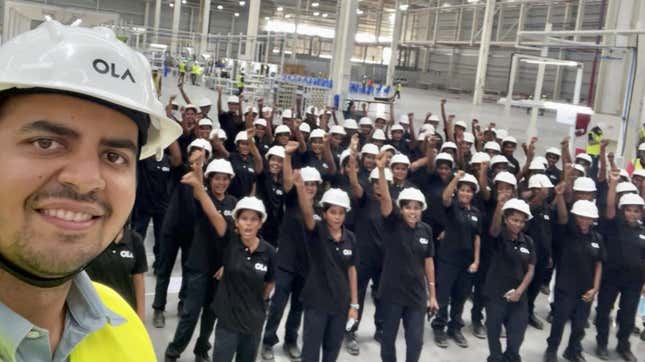To modern workers everywhere,
The White House surprised the US private sector on Sept. 9 by announcing it would ask the Occupational Safety and Health Administration (OSHA) to direct companies of more than 100 employees to adopt Covid-19 vaccination mandates. US president Joe Biden said that “patience is wearing thin” with the 25% of eligible Americans who have yet to get vaccinated.
Some Republican leaders are already calling on employers to ignore Biden’s proposed rule, despite the risk that Covid-19 poses to employees’ health. Meanwhile, costs of the technology and labor required to verify that workers are vaccinated or that they have tested negative every week may seem onerous or politically unjustifiable by some company owners. All of which is to say that once a new OSHA rule is issued formally and withstands any legal challenges, there will almost certainly be employers who ignore the requirement.
So then what happens? And can workers do anything about it?
According to legal experts who spoke with Quartz, yes. In fact, workers could play a major role in helping OSHA police the new mandates.
Workers can’t sue their employer directly for violating OSHA rules, but they can file complaints or become whistleblowers. Although OSHA is not known for being aggressive, that could change. The agency might decide to make examples of noncompliant companies, naming and shaming them and hitting them with heavy fines to serve as a warning to other businesses. For employers who were on the fence about adopting a vaccine mandate, both Biden’s measure and the threat of penalties will give them political cover to move forward and provide clarity.
Ian Carleton Schaefer, who chairs the New York employment and labor practice at the law firm Loeb & Loeb in New York City, gives Biden credit for “a significant, and really game-changing type of directive that might not have precedent in modern labor history.” It’s also going to present employers with “difficult choices” about employees who object to both testing and vaccination, he says. Meanwhile, it’s so far unclear how the rule will apply to remote workers, but Schaefer believes companies should expect that it will.—Lila MacLellan
Read more on this topic here.
Five things we learned this week
Microsoft Teams may have found the answer to the “you’re on mute” problem. Whether the new feature takes hold will depend on how quickly users can train themselves on the push-to-talk function.
How to respond when a job interviewer says “Tell me about yourself.” It’s often a throwaway question, but it can cause a lot of complications for candidates.
The best vacation has no itinerary. For busy people, the value of a vacation lies in committing yourself to doing nothing at all.
US hospitals are losing more nurses than ever to lucrative contract work. A traveling nurse can now earn $5,000 or more per week.
Today’s workshop: How to run a company that remote employees love

Last week we debuted our inaugural ranking of the Best Companies for Remote Workers. This week, you’ll get to hear directly from leaders of the small, medium, and large firms on our list and learn how top-rated employers keep their remote workers happy and engaged. Join us today—Wednesday, Sept. 15—from 11am-noon US eastern time for a free live event.
Register here.
Meet the cloffice
The term may be new, but the “cloffice”—essentially a workstation that can be tucked away in a closet—has routinely been used to lampoon poor, low-rung employees doomed to work in a windowless storage room. (Remember Ryan’s demotion to the Dunder Mifflin janitor’s closet on The Office? Higgins’ super-tight supply closet arrangement in Ted Lasso? Milton’s humiliation in Office Space?)
But scroll through the range of enviable compact home offices today and there’s good reason to retire this comic trope. “The cloffice is here to stay!” Mélanie Berliet, SVP of Dotdash’s lifestyle site The Spruce, declared this week at the “Future of Home” conference. She predicts that the lockdown decorating trend—a nifty solution for remote workers living in tight quarters—will become a standard fixture as more organizations embrace hybrid work.
They’re reminiscent of classic space-saving home office solutions like the under-the-stairs work nook, the homemaker’s kitchen office, or even drop-front secretary desks. Save for their regretful portmanteau, the 2021 cloffice need not be droll or demoralizing. With planning, paint, organizing boxes, maybe a scrap of wallpaper, they can be clever solutions for remote employees who want to close the door on any reminders of work at the end of the day.—Anne Quito
30-second case study
When it’s running at full capacity, the Ola Future Factory—the Tamil Nadu plant where Indian ride-hailing giant Ola will be producing its highly anticipated electric scooters—will be rolling out one scooter every two seconds. And it will do so with the help of 10,000 workers, all of them female.
“Today, I am proud to announce that Ola Futurefactory will be run entirely by women,” Ola CEO Bhavish Aggarwal announced in a company blog post.
So far, hundreds of women have already arrived at the plant, where they will carry out maintenance and repairs and fill a variety of technical roles, from production assistants to supervisors, while 3,000-odd robots are at work. All of the women there now are starting as trainees. Once they transition to full-time employment, they’ll be eligible for benefits such as medical insurance and maternity leave.
Ola, as Quartz India reporter Ananya Bhattacharya notes, wouldn’t be the first company to have a 100% female factory in India. Kirloskar Brothers, which produces industrial valves, has been running a women-only factory in Coimbatore for over a decade now, and Mumbai-based consumer goods behemoth Hindustan Unilever has since December 2014 had a 100% female shop floor at its Haridwar plant. But these companies are in the minority. On average, women fill a mere 12% of manufacturing jobs in India.
The takeaway: Employers in India often feel women are better at following complex instructions and are more dextrous, while also taking fewer breaks and registering higher attendance. All of this suggests they’d be well-suited to factory jobs. But women are shockingly deprived of dependable role models in the sector. The biggest reason women have been kept out? They are not, supposedly, cut out for the manual labor. However, in the age of automation, that argument seems obsolete.
“There are misconceptions that women cannot work in manufacturing because there is a lot of heavy lifting to do. And yet, today’s automated shop floors mean that everything is mechanized and there are hauls and lifts that do all the heavy lifting,” Gajendra Chandel, former chief HR officer at Tata Motors, said in 2017.
Ola suggests its factory plans will make good on a commitment to create more inclusive work environments and provide economic opportunities to women. And the benefits, it suggests, will be far broader. “For India to be the world’s manufacturing hub, we must prioritize upskilling and generating employment for our women workforce,” Aggarwal said, citing studies that suggest giving women parity in the labor force can increase India’s GDP by 27%.

Words of wisdom
“Meeting/event invites that don’t result in a calendar invite may as well be something I dreamed”—Twilio co-founder John Wolthuis, tweeting on behalf of us all.
Incoming
What goes great with a new cloffice? A Quartz membership! If you’re not yet a member, sign up today with the code QZEMAIL40 and take 40% off your first year. You’ll get access to member-exclusive emails including:
🔮 The Forecast: a short, sharp look forward at an emerging industry, technology, or trend
🏢 The Company: context on the companies changing (or about to change) the way other businesses work (companies like Coinbase, Discord, Krispy Kreme, and Shein)
💻 How To: specific things you can do to work more effectively and solve problems you care about (from spending too much time with your phone, to managing your team’s return to the office, to creating a digital office culture)
💡 The Quartz Weekend Brief: our weekly perspective on the news is now a membership exclusive
ICYMI
“Look at that coloring, the tasteful thickness of it.” A YouTube user who goes by the name OwlKitty cleverly edited out the business cards shared by Patrick Bateman and his co-workers in the classic scene of the 2000 dark comedy American Psycho. In the parody, the characters instead show off smartphones sporting cat photos—and it’s amazing.
You got The Memo!
Our best wishes for a productive, well-managed week. Please send any workplace news, cloffice decorating ideas, and envy-producing cat photos to [email protected]. Get the most out of Quartz by downloading our app and becoming a member. This week’s edition of The Memo was produced by Ananya Bhattacharya, Heather Landy, and Sarah Todd.
